|
|
|
Sort Order |
|
|
|
Items / Page
|
|
|
|
|
|
|
| Srl | Item |
| 1 |
ID:
122005
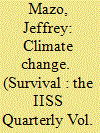

|
|
|
|
|
| Publication |
2013.
|
| Summary/Abstract |
Climate change caused by global warming is, arguably, a serious, even existential, threat to the world order and to the welfare of humanity. No one really knows; there are many uncertainties around the rate of warming and the severity of its environmental and social impacts, and hence the most effective, and cost-effective, ways to avoid or ameliorate them. But over the last five or six years, public discourse has been driven less by policy needs and more by punditry. The propagation of myths and misconceptions, whether deliberate or inadvertent, continues to poison the debate over how to mitigate or adapt to climate change.
|
|
|
|
|
|
|
|
|
|
|
|
|
|
|
|
| 2 |
ID:
122427
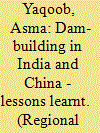

|
|
|
| 3 |
ID:
132497
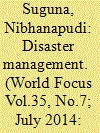

|
|
|
|
|
| Publication |
2014.
|
| Summary/Abstract |
Hundreds of Natural disasters take place worldwide every year causing irreparable damage to life and property. Earthquakes, ?oods, typhoons, hurricanes,- Tsunamis are among the worst of these natural disasters. Over the last few decades, there has been an alarming increase in the occurrence of natural disasters and the magnitude of their social, economic and environmental impact. During any natural disaster it is usually the" children who suffer the most. The nation witnessed the death of nearly a thousand children during the 2001 Bhuj earthquake. Out of them, 300 died while marching for the Republic day parade. They were in a narrow lane when the earthquake hit causing buildings onboth sides to collapse. It is said thatpnearly 1,884 school buildings collapsed leading to a loss of 5,950 class rooms. About 12000 schools suffered damages making them un?t for children to continue their studies. Fire tragedies, like the one in Kurnbakonam killed 93 children in a school. Another ?re accident in Dabwali, Haryana where a ?re broke out during a schoolfunction took he lives of many school children. Children in schools are the 'most vulnerable group during any disaster. These tragedies reiterate the need for all of us to sit up and think about the safety of these children. It is necessary to make schools safe and hazard proof. For this purpose, it is important to have disaster management, emergency preparedness and response plans at school level.
|
|
|
|
|
|
|
|
|
|
|
|
|
|
|
|
| 4 |
ID:
132498
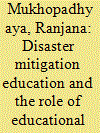

|
|
|
|
|
| Publication |
2014.
|
| Summary/Abstract |
Disasters are increasing exponentially. The number of disaster events which was 73 in 1900-09 has increased to 4494 during 2000-09. More people were affected in the two recent decades than the earlier ones. During the second half of the 20th century, more than 200 major natural disasters occurred in different parts of the world and claimed the lives of around 1.4 million people. In 2011 alone, 302 hazards resulted in disasters that claimed almost 30,000 lives, affected 206 million people and in?icted damages worth an estimated USS 366 billion, according to the United Nations Office for Disaster Risk Reduction.
|
|
|
|
|
|
|
|
|
|
|
|
|
|
|
|
| 5 |
ID:
121202
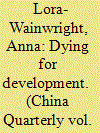

|
|
|
| 6 |
ID:
127515
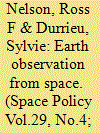

|
|
|
|
|
| Publication |
2013.
|
| Summary/Abstract |
Remote sensing scientists work under assumptions that should not be taken for granted and should, therefore, be challenged. These assumptions include the following:
1. Space, especially Low Earth Orbit (LEO), will always be available to governmental and commercial space entities that launch Earth remote sensing missions.
2. Space launches are benign with respect to environmental impacts.
3. Minimization of Type 1 error, which provides increased confidence in the experimental outcome, is the best way to assess the significance of environmental change.
4. Large-area remote sensing investigations, i.e. national, continental, global studies, are best done from space.
5. National space missions should trump international, cooperative space missions to ensure national control and distribution of the data products.
At best, all of these points are arguable, and in some cases, they're wrong. Development of observational space systems that are compatible with sustainability principles should be a primary concern when Earth remote sensing space systems are envisioned, designed, and launched. The discussion is based on the hypothesis that reducing the environmental impacts of the data acquisition step, which is at the very beginning of the information stream leading to decision and action, will enhance coherence in the information stream and strengthen the capacity of measurement processes to meet their stated functional goal, i.e. sustainable management of Earth resources. We suggest that unconventional points of view should be adopted and when appropriate, remedial measures considered that could help to reduce the environmental footprint of space remote sensing and of Earth observation and monitoring systems in general. This article discusses these five assumptions in the context of sustainable management of Earth's resources. Taking each assumption in turn, we find the following:
(1) Space debris may limit access to Low Earth Orbit over the next decades.
(2) Relatively speaking, given that they're rare event, space launches may be benign, but study is merited on upper stratospheric and exospheric layers given the chemical activity associated with rocket combustion by-products.
(3) Minimization of Type II error should be considered in situations where minimization of Type I error greatly hampers or precludes our ability to correct the environmental condition being studied.
(4) In certain situations, airborne collects may be less expensive and more environmentally benign, and comparative studies should be done to determine which path is wisest.
(5) International cooperation and data sharing will reduce instrument and launch costs and mission redundancy. Given fiscal concerns of most of the major space agencies - e.g. NASA, ESA, CNES - it seems prudent to combine resources.
|
|
|
|
|
|
|
|
|
|
|
|
|
|
|
|
| 7 |
ID:
127244


|
|
|
|
|
| Publication |
2014.
|
| Summary/Abstract |
There is an increasing political pressure on the city planning to create more energy efficient city plans. Not only do the city plans have to enable and promote energy efficient solutions, but it also needs to be clearly assessed how energy efficient the plans are. City planners often have no or poor know how about energy efficiency and building technologies which makes it difficult for them to answer to this need without new guidelines and tools. An easy to use tool for the assessment of the energy efficiency of detailed city plans was developed. The aim of the tool is for city planners to easily be able to assess the energy efficiency of the proposed detailed city plan and to be able to compare the impacts of changes in the plan. The tool is designed to be used with no in-depth knowledge about energy or building technology. With a wide use of the tool many missed opportunities for improving energy efficiency can be avoided. It will provide better opportunities for sustainable solutions leading to less harmful environmental impact and reduced emissions.
|
|
|
|
|
|
|
|
|
|
|
|
|
|
|
|
| 8 |
ID:
127215


|
|
|
|
|
| Publication |
2014.
|
| Summary/Abstract |
The goal of optimising the energy yield of renewables sits uneasily with the politics and processes of planning for wind turbines. In countries such as the UK the land-use planning consent regime is not concerned with the energy yield of proposed wind developments. This is a matter for the developer rather than the regulator, which might seem curious given the policy commitment to maximising the potential for renewable energy generation and the need to weigh up local environmental impacts with emissions reduction. In this paper, we highlight and investigate the implications of the exclusion of energy yield from wind turbine regulation. The case is made for increasing the weight given to energy yield within Environmental Impact Assessment and the land-use planning process.
|
|
|
|
|
|
|
|
|
|
|
|
|
|
|
|
| 9 |
ID:
127224


|
|
|
|
|
| Publication |
2014.
|
| Summary/Abstract |
The maximum amount of land for growing switchgrass for ethanol is estimated for a region in the southeastern U.S. Breakeven capacities are calculated for land in row crops, hay, pasture and marginal land. Characteristics of land categories inform potential land use change impacts as well as switchgrass profitability. Variable yields within and across land categories are translated into distributions of switchgrass net revenue. Breakeven curves are generated for a range of switchgrass prices. These curves provide upper bounds for further analysis of actual switchgrass adoption in context of broader economic forces and possible policy mechanisms to minimize environmental impacts. A farm-gate price of $55 Mg?1 is estimated for half of marginal and pasturelands to break even with switchgrass. At this price, only 20% of land in hay and a small fraction of row crop hectares break even. Half of hay and row crops hectares break even at approximately $90 Mg?1 and $100 Mg?1, respectively. At $60 Mg?1, sufficient land area can profitably produce switchgrass for ethanol to displace approximately 10% of gasoline consumed in Georgia, North Carolina, and South Carolina; however, this price only indicates breakeven capacity implying that higher prices may be necessary to realize 10% displacement.
|
|
|
|
|
|
|
|
|
|
|
|
|
|
|
|
| 10 |
ID:
131365


|
|
|
|
|
| Publication |
2014.
|
| Summary/Abstract |
Despite criticism, global biofuel production continues to rise, using primarily food crops. Between 2001 and 2012 it increased nearly six-fold, driven primarily by domestic policies, yet raising strong international concerns, eg over impacts on global food prices. Nevertheless, little international biofuel governance has emerged. This article examines the various extraterritorial dimensions of domestic biofuel policies and investigates why international biofuel governance has remained vague, despite its controversial nature. It uses the politics of scale to analyse why countries may wish to frame it as a global or domestic issue. Three extraterritorial dimensions are identified: global environmental impacts, global socioeconomic impacts, and attempts at extraterritorial control over biofuel production abroad. While major producers have successfully avoided liability for impacts by preventing the scaling up of much biofuel governance to the international level, major importers have tried to fill perceived governance gaps using policies aimed at extraterritorial control. We show that both the rise of nationally oriented development policies with extraterritorial impacts and of unilateral sustainability rule making primarily affect weaker countries, making global inequalities more pronounced. It is essential that adaptation governance take into account both environmental and global socioeconomic changes, such as higher agricultural commodity prices.
|
|
|
|
|
|
|
|
|
|
|
|
|
|
|
|
| 11 |
ID:
091432


|
|
|
|
|
| Publication |
2009.
|
| Summary/Abstract |
In recent years, the government of the Philippines has engaged in efforts to encourage nonferrous metals mining as a means of accelerating economic development. Mining is an activity with a substantial potential for environmental degradation. Mining projects in the Philippines are subjected to an environmental impact assessment process that is designed to operate in the minimum amount of time and with the minimum amount of inconvenience to the project proponent. This process does not properly consider biodiversity, ethnodiversity, alternatives to the project, and the cumulative effects of the project. This process also avails a minimal amount of opportunities for members of the public to participate. This environmental impact assessment process is a tokenism designed to make it appear that mining projects are being assessed for their environmental effects while they receive their inevitable predetermined approval.
|
|
|
|
|
|
|
|
|
|
|
|
|
|
|
|
| 12 |
ID:
127230


|
|
Impact on electricity demand and emissions due to the introduct
/ Dias, Marcos Vinícius Xavier; Haddad, Jamil; Nogueira, Luiz Horta; Bortoni, Edson da Costa, Cruz, Ricardo Alexandre Passos da, Yamachita, Roberto Akira, Goncalves, Jose Luiz
|

|
|
|
|
| Publication |
2014.
|
| Summary/Abstract |
Over the past years, the pursuit of using less polluting energy sources throughout society has been on the increase. In general, the transportation sector is responsible for most of the emissions of greenhouse gases. Therefore, in this article a methodological approach is applied in such a way that it is possible to quantify the impact of the penetration of electric vehicles vis-à-vis others that use different types of fuel (flexible fuel, for example). The study is conducted for a road modal in São Paulo, the main state in Brazil in terms of economy, energy and environment, taking into account only automobiles. A comparative analysis of forecasting scenarios until 2035 for various inputs of electric cars in the whole state fleet is presented, aiming to verify the susceptibility of the model suggested, upon the introduction of electric vehicles, taking into account also the electrical and environmental impacts related to it. The analysis was possible due to the use of a simulation tool, Long range Energy Alternatives Planning System (LEAP), which is an energy environmental model based on scenarios, allowing an integrated and reliable support to develop studies on integrated energy planning.
|
|
|
|
|
|
|
|
|
|
|
|
|
|
|
|
| 13 |
ID:
099616
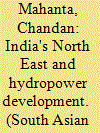

|
|
|
|
|
| Publication |
2010.
|
| Summary/Abstract |
Hydropower, while being projected as a clean and renewable energy source, has time and again been resisted vociferously in North East India in recent times because of the obvious and unintended social and environmental impacts. The anticipated negative impacts of the associated dam and reservoir construction have cast a threat to the security of the indigenous people in terms of water, food, livelihood, energy and above all, the related socio-economic concerns. This is all the more due to the uncertainties flowing from an inadequate understanding of the possible geo-environmental impacts in a highly sensitive terrain. To cope and live with the potential negative ramifications of hydropower projects, a comprehensive hydropower policy with emphasis on long-term environmental and social security and sustainability is imperative.
|
|
|
|
|
|
|
|
|
|
|
|
|
|
|
|
| 14 |
ID:
123721


|
|
|
|
|
| Edition |
Ist
|
| Publication |
New Delhi, Academic Foundation, 2013.
|
| Description |
p.278
|
| Standard Number |
9789332700307
|
|
|
|
|
|
|
|
|
|
|
|
Copies: C:1/I:0,R:0,Q:0
Circulation
| Accession# | Call# | Current Location | Status | Policy | Location |
| 057447 | 333.79240954/RAJ 057447 | Main | On Shelf | General | |
|
|
|
|
| 15 |
ID:
105824


|
|
|
|
|
| Publication |
2011.
|
| Summary/Abstract |
The dramatic scale-up of renewable energy over the coming decades is likely to pose significant challenges for coordinating land use allocation, environmental assessment, energy system planning and the design of greenhouse gas abatement policy. Of particular concern is the establishment of institutions and processes that enable consideration of multiple objectives and attributes, with adequate representation of affected interests, and without resulting in excessive delays in the development of renewable energy as part of a greenhouse gas abatement strategy. This paper uses the Canadian province of British Columbia as a case study for describing these challenges and the responses of policy makers seeking to rapidly scale-up renewables. Using evaluative criteria to assess this experience, we identify lessons that may be applicable to other jurisdictions seeking to quickly expand the production of renewable energy. These lessons include the design of institutions and processes that would likely be required in almost any jurisdiction with similar aims.
|
|
|
|
|
|
|
|
|
|
|
|
|
|
|
|
| 16 |
ID:
121346


|
|
|
|
|
| Publication |
2013.
|
| Summary/Abstract |
The rapid application of carbon capture and storage (CCS) is a much heralded means to tackle emissions from both existing and future sources that, however, simply may not deliver the expected benefits. Apart from some doubts about the efficacy of the geological storage, the present stall in deploying carbon capture and storage (no fossil-fuel power plants, the greatest source of carbon dioxide emissions, are presently using carbon capture and storage, and publicly supported demonstration programmes are struggling to deliver actual projects) is due to the simple fact that the move to carbon capture and storage would have considerable additional costs for the economy and the environment that would very likely offset all the benefits.
|
|
|
|
|
|
|
|
|
|
|
|
|
|
|
|
| 17 |
ID:
162965


|
|
|
|
|
| Summary/Abstract |
Non-renewable technologies still play a significant role in the electricity generation mix of most countries. Thus, relevant up-to-date environmental data are needed to provide a good understanding of the environmental consequences of the fossil fuel electricity generation technologies. The focus of this work is to examine the fossil-based electricity generation technologies used in Ecuador, providing a compelling insight into the revision of existent international databases. The main combinations of fossil fuel and thermal generation technologies have been studied: fuel oil in steam power plants (FO-SP), fuel oil in internal combustion engine power plants (FO-ICE), natural gas in gas turbine power plants (NG-GT), and diesel in gas turbine power plants (D-GT). ISO standards and CML 2000 methodology were further considered to quantify the potential environmental impact associated with the systems. Results show that NG-GT has the lowest environmental burdens, while FO-SP represents the highest impacts in 5 of the 6 studied impact categories. It is remarkable that for the same type of fuel (fuel oil), the ICE power plants have a lower environmental impact than FO-SP plants. Finally, lights and shadows of fossil-based electricity are discussed to provide a general picture of the current debate concerning transition pathways.
|
|
|
|
|
|
|
|
|
|
|
|
|
|
|
|
| 18 |
ID:
098657


|
|
|
|
|
| Publication |
2010.
|
| Summary/Abstract |
This paper presents a methodology for the assessment of the impact of existing high voltage lines in urban areas. This methodology is based on the numeric evaluation of several impacts which are combined with weight factors. The novelty is that it opens up the possibility of citizen participation, basically in the way in which impacts and weighting factors are determined. The proposed methodology has been applied first in the municipality of Rubí, a mid-sized town near Barcelona, and later on in several municipalities in the Catalonia region in Spain. The results were used to prioritise mitigation action in the Catalonia Energy Plan.
|
|
|
|
|
|
|
|
|
|
|
|
|
|
|
|
| 19 |
ID:
104174
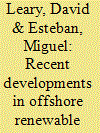

|
|
|
|
|
| Publication |
2011.
|
| Summary/Abstract |
This article examines the emergence of offshore renewable energy (i.e., offshore wind, ocean, and tidal energy) in the Asia-Pacific region with a particular focus on developments in China, South Korea, Australia, and New Zealand. It outlines plans for the development of offshore wind, tidal, and wave energy projects as well as emerging legal and policy measures supporting the growth of offshore renewable energy in the region. The article highlights that, although some progress has been made on laws and other measures to facilitate offshore renewable energy in the Asia-Pacific region, clear regulatory frameworks are still emerging in these jurisdictions.
|
|
|
|
|
|
|
|
|
|
|
|
|
|
|
|
| 20 |
ID:
141403
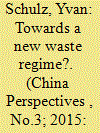

|
|
|
|
|
| Summary/Abstract |
This article explores how a multitude of entities vie for control over discarded electrical and electronic appliances in China. It analyses the strategies they deploy in order to gain or keep a competitive edge. Central government agencies, scientific research institutes, and large recycling groups, in particular, have recently joined forces with a view to redirecting flows of valuable consumer goods away from the so called “informal” sector of the economy, notably by creating high barriers to entry. They strive to distinguish themselves from small-scale recyclers by making ample use of green propaganda and narratives of technological progress. However, China’s state-sanctioned “management system” for “e-waste” recycling is not nearly as environmentally friendly as its proponents claim. It promotes a waste regime centred on "resources" – not products – and thereby contributes to accelerating and extending material cycles. Fully understanding its nature and impact requires seeing the link to other national policies, especially those promoting growth.
|
|
|
|
|
|
|
|
|
|
|
|
|
|
|
|
|
|
|
|
|